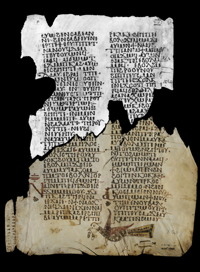 It is not a new fact that we deal in case of the Sahidic Bible with a very fragmentary manuscript tradition. However, the inquisitive researcher is sometimes rewarded with surprising succes. During our research trip to London in 2017 we visited also the Victoria and Albert Museum where Alin Suciu had detected some Coptic manuscript fragments. Among them was the lower half of a parchment leaf with passages from the book of Jeremiah. Thanks to the generosity of the VAM staff we received soon good images and information about the purchaser of this fragment. The painter, ceramics specialist, and collector Henry Wallis (1830–1916) must have acquired the fragment in Egypt before 1888, when it entered the VAM according to the inventory (and acquisition) number VAM 434A-1888. As we will see below, Wallis gave also manuscripts to the British Museum. He was, however, certainly more interested in the illumination of the leaf than in its biblical text content.
It is not a new fact that we deal in case of the Sahidic Bible with a very fragmentary manuscript tradition. However, the inquisitive researcher is sometimes rewarded with surprising succes. During our research trip to London in 2017 we visited also the Victoria and Albert Museum where Alin Suciu had detected some Coptic manuscript fragments. Among them was the lower half of a parchment leaf with passages from the book of Jeremiah. Thanks to the generosity of the VAM staff we received soon good images and information about the purchaser of this fragment. The painter, ceramics specialist, and collector Henry Wallis (1830–1916) must have acquired the fragment in Egypt before 1888, when it entered the VAM according to the inventory (and acquisition) number VAM 434A-1888. As we will see below, Wallis gave also manuscripts to the British Museum. He was, however, certainly more interested in the illumination of the leaf than in its biblical text content.
About the same time, the upper half of the leaf must have come, together with other fragments, to the British Museum. The British Museum curator, Ernest A. Wallis Budge (1857–1934) acquired it apparently himself. W.E. Crum informs us about in his catalogue of the Coptic Manuscripts in the British Museum (1905, p. x): "The first instalment to reach here was that brought in 1886 by Mr. H. Wallis (Or. 3367); a far larger quantity was obtained in 1888 through Dr. Budge (Or. 3579-3581), to whom indeed, more than to any other, the British Museum owes its large acquisitions of Coptic MSS." In the 1970s this fragment with the inventory number Or. 3579 A.32, together with the entire Coptic manuscript collection, was transferred to the British Library, where it is kept still today. For more than 100 years, the two halves of the leaf were deposited in London in different collections, and nobody found out that they actually form a single leaf, because the VAM fragments remained unknown to Coptologists.
Our team discovered via the biblical text content that these fragments belong together and the virtual reconstruction shows that the parchment leaf is almost intact. The leaf belonged to the White Monastery Codex sa 2059 (9th–10th century), and it is the first extant leaf of 20 which survived from this codex with the books Jeremiah, Baruch, Lamentations, and Epistle of Jeremiah. Typically, the remaining leaves and fragments are dispersed, besides our two collections in London, over the collections in Ann Arbor (MI, USA), Manchester (UK), Paris (BNF and Louvre), and Vienna. After having read this breath taking discovery report you can vistit the re-unified leaf (already transcribed) with all the other leaves in the original sequence (the other leaves will be indexed and transcribed successively) in our Virtual Manuscript Room.
However, the story can still be enlarged. If you take a careful look at the color image of the lower manuscript half (VAM) you recognize at the lower outer margin of the leaf that a parchment strip was glued to the folding of the (former) double leaf to stabilize it, a quite typical procedure with parchment manuscripts. Interestingly, the strip bears the rests of the Greek text of John 6:52! So, material of still another (Greek) parchement manuscript was used to maintain the material integrity of the manuscript. Who knows what the other leaves of the manuscript still conceal?
 Blogs
Blogs  Recent Bloggers
Recent Bloggers 




